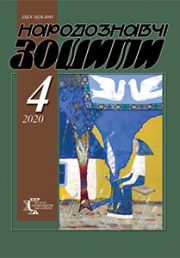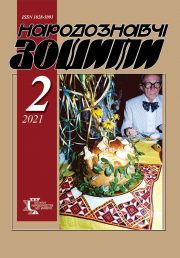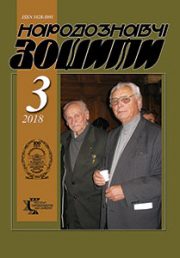The Ethnology Notebooks. 2022. № 1 (163), 16—30
UDK 069.12-044.252(477)”2000/…”
DOI https://doi.org/10.15407/nz2022.01.016
INTERACTIVITY, INCLUSION AND PARTYSYPATION AS MAIN LINES OF INNOVATIVE PRACTICES OF MUSEUM WORK
KUSHNIR Vitalii
- ORCID ID: https://orcid.org/0000-0001-8809-0108
- Candidate of Historical Science,
- Research Fellow,
- Museum of Ethnography and Art Crafts
- Of the Institute of Ethnology of the National Academy of Science of Ukraine,
- 15, Svobody ave., 79000, Lviv, Ukraine,
- Contacts: e-mail: vitaliy_val@ukr.net
Abstract. Formulation of the problem. In the decades after the Second World War, profound changes in museums’ vision of their social role and place in the socio-cultural space were embodied in new forms of museum practice, new technologies of museum communication, which over time became firmly established in modern museums. Today, they are gaining a stronger position in the current Ukrainian museum practice. Against the background of considerable achievements in this direction of development, some moments of changes in the work of museums encourage critical reflection. On the other hand, many Ukrainian museums are unacceptably lagging behind the requirements of the time in implementing the changes in their work, on the need for which there is a consensus in the museum environment today.
The aim of the article is to analyze, in a broad museological context, interactive technologies of museum work, inclusive components of museums, as well as participatory museum activity, highlight the current experience of domestic museums in these areas and features of their implementation in Ukrainian museum practice.
The chronological framework of the paper is determined by the period after 2000, when, against the background of the rapid development of museological research in Ukraine, the process of transformation of all major areas of practical activities of museums has accelerated significantly.
The analysis of new forms of work of Ukrainian museums allowed to allocate, among a wide range of museum innovations, interactive forms of work, inclusiveness, and also museum participation. Their common feature is the desire to attract audiences more and deeper to the museum space. Today, interactivity and inclusion are becoming more common in the current practice of Ukrainian museums, a «must have» of museum work. Participatory museum work is currently represented by the initiatives of individual museums. At the same time, innovative museum practices sometimes pose questions to museum workers who don’t have obvious or simple answers, and encourage them to find a balance between innovation and traditional museum tasks.
Keywords: museology, museum practice, museum inclusion, interactivity, participatory museum activity.
Received 11.01.2022
REFERENCES
- Svencicki,I. (1920). About museums and museology. Essays and notes. Lviv: Dilo [in Ukrainian].
- Korotkova, A. (2011). Art Museum as an educational center. Bulletin of the RSUH. Scientific journal. Series «Culturology. Art history. Museology», 17 (79)/11, 305—312 [in Russian].
- Michael, J. Mulrian. (2001). John Cotton Dana, John Dewey and the Creators of the Newark Museum: A Collaborative Success in the Art of Progressive, Visual Instruction. Seton Hall University. eRepository@Seton Hall. Retrieved from: http:// scholarship.shu.edu/cgi/viewcontent.cgi (access date: 02.10.2021).
- Anastadiades, S. John Cotton Dana and the Mission of the Newark Museum, 1909— 1929. Theses. Seton Hall University and Repository@Seton Hall (Pp. 27—29). Retrieved from: http://scholarship.shu.edu/theses/241 (access date: 05.10.2020).
- Ananyev, V. (2014). History of foreign museology. St. Petersburg [in Russian].
- Ananiev, V. (2013). Leicester School of Museology: history, personalities, ideas. Bulletin of St. Petersburg University (Ser. 2, issue 2, pp. 127—134) [in Russian].
- Banach, V. (2016). Museum innovations and interactivity in the theory and practice of museum work. Historical and Cultural Studies, 1 (Vol. 3, pp. 1—5) [in Ukrainian].
- Shevchenko, O. (2016). Interactive tour as a basis of museum communication (on the example of the Art Memorial Museum of I. Repin). Bulletin of Odessa Museum of local history (Issue 15, pp. 71—75) [in Ukrainian].
- Ivanets, O. (2009). The latest approaches in museum practice. Matra/Museums of Ukraine (from the experience of the city museum of local lore in Netishyn). History of museum work, monument protection, local folrlore and tourism in Ostroh and Volyn (Issue 2, pp. 48—51) [in Ukrainian].
- Trofimenko, T. (2012). Interactive methods of working with visitors as a kind of museum communication (from the practice of the Kharkiv Literature Museum). Eighteenth Sumtsov Readings: Proceedings of the Scientific Conference «Museum as a Socio-Cultural Institute in the Information Society», april 18, 2012. (Kharkiv) [in Ukrainian].
- Exhibits of the House of Franko in Lviv will «speak». Retrieved from: www.ukrinform.ua/rubric-tourism/2586096-eksponaty-domu-franka… (access date: 15.12.2019) [in Ukrainian].
- Music «came to life» in the Museum of Ethnography and Crafts. Retrieved from: https://photo- lviv/in/ua/v-muzei-etnografii… (access date: 10.01.2019) [in Ukrainian].
- Nadolska, V. Game as an interactive form of museum activity. Lviv Politechnik National University Institutional Repository. Retrieved from: http://ena.lp.edu.ua [in Ukrainian].
- Sukhodolya, L. (2013). Museum and children. Scavenger Hunt. Museum space, 1 (7), 30—33 [in Ukrainian] [in Ukrainian].
- Vihor, O. (2012). Interactive museum for everyone. Museum space, 6, 50—51 [in Ukrainian].
- Bryzhachenko, N. (2013). Classification of museum-exhibition spaces organized with the use of interactive technologies. Bulletin of the KhDADM, 3, 62—67 [in Ukrainian].
- Bicycle with square wheels and debunking myths: interactive «Museum of Science» opened in Kyiv. Retrieved from: www.5.ua/nauka/velosyped…-255666.html (access date: 30.11.2019) [in Ukrainian].
- Karpenko, Yu., & Pashchenko, Yu. (2018). Interactive museums in the development of the information society. Documentary and information communications in the context of globalization: Proceedings of the III All-Ukrainian scientific-practical conference, Poltava, november 22, 2018. Poltava [in Ukrainian].
- Chorna, Milena (2020). True inclusion: not wrong, just different. 04/30/2020. Retrieved from: www.ua.culture.org/texts/spravzhnia-inklusia…(access date: 12.05.2020) [in Ukrainian].
- Yasenovska, M., & Zinenko, O.(2020). Best practices of inclusion. Friedrich Ebert Foundation [in Ukrainian].
- Kravchenko, Raisa, & Rudyk, Anna (2020). Accessibility of museums for people with intellectual disabilities. Guidelines. With the support of the Ukrainian Cultural Foundation. Kyiv [in Ukrainian].
- Mikhno, O. (2019). Inclusion as a direction of work of the Pedagogical Museum of Ukraine. Art museum: past and present. Collection of Scientific articles (Issue III,pp. 53—57). Chernihiv [in Ukrainian].
- Khanenko Museum presents an inclusive site. Retrieved from: https: responsiblefuture.com.ua/muzej-hanenkiv-prezentuvav…30.10.2019 (access date: 30.11. 2019) [in Ukrainian].
- The website of the Museum of Folk Art of Hutsul and Pokuttya will be inclusive and bilingual. Retrieved from: https://report.if.ua/socium/sajt-muzeyu-narodnogo-mystectva… (acces date: 30.06.2021) [in Ukrainian].
- Virtosu, Irina. Affordable Art, or How to Get to a Museum? Retrieved from: https: ud.org.ua (acces date: 30.06.2020) [in Ukrainian].
- Lviv museums will «speak» in sign language. Retrieved from: www.galinfo.com/ua/news/lvivski_muzei_zagovoriat… (access date: 17.06.2021) [in Ukrainian].
- A unique tactile exhibition in the Pinzel Museum has opened in Lviv. Retrieved from: https://4 studio.com.ua/novyny/u-lvovi-zapratsuvala-unikalna… [in Ukrainian].
- Touch paintings for the blind are being created at the Kharkiv Art Museum. Retrieved from: https://www.suspilne.media/167468-u-hudoznomu-muzei-harkova… (access date: 27.09.2020) [in Ukrainian].
- Chekanova, N. (2021). The principle of equality and tolerance in the activities of the Ternopil Regional Museum of Local Lore. The All-Ukrainian interdisciplinary scientific-practical conference «Inclusive education: idea, strategy, result», april, 8, 2021 (Pp. 195—198) [in Ukrainian].
- Rivne region will make museums inclusive. Retrieved from: https: //www.istpravda.com.ua/short/2020/07/22/157844 (access date: 15.05.2021) [in Ukrainian].
- Retrieved from: www.fes.kiev.ua/n/cms/25/ (access date: 03.10.2021) [in Ukrainian].
- Accessible museum: inclusion in the museum space. Retrieved from: https: //www.prostir.museum/ua/post/41664 (access date: 07.10.2021) [in Ukrainian].
- Shuklina, E., & Kamensky, Yu. (2015). Participatory museum: a crucial interaction model in museum communities. Strategies for the development of social communities, institutions and territories: Proceedings of the International Scientific and Practical Conference, Yekaterinburg, April 23—24, 2015 (Vol. 1, pp. 53—56). Yekaterinburg [in Russian].
- Klyuchko, Yu. (2016). Modern educational practices of the museum in the context of the paradigm of participatory culture. Ukrainian culture: prospects for European integration. Innovative processes in modern culture. Proceedings of the All-Ukrainian scientific-practical conference, April 7—8, 2016, Kyiv (Ch. 1, pp. 62—65) [in Ukrainian].
- Aganova, D. (2021). Museum communication in the spirit of participatory culture. Culture or culture: participatory practices in museums (Pp. 66—98). Kyiv: Publisher Cherednichekno A.M. [in Ukrainian].
- Simon, Nina. (2010). The Participatory Museum. Santa Cruz, California: MUSEUM.
- Klyuchko, Yu. (2018). Practices of developing a creative approach in the educational activities of the museum. Bulletin of the Kyiv National University of Culture and Arts. Series: Museum Studies and Monument Studies (Issue 1) [in Ukrainian].
- Cult or culture: the development of participatory practices in museums. Retrieved from: www.museum.pologi.info/ kult-chy-kultura (access date: 07.10.2021) [in Ukrainian].
- Retrieved from: www.krytyka.com/ua/reviews/kult-chy-kultura… (access date: 08.10. 2021) [in Ukrainian].







